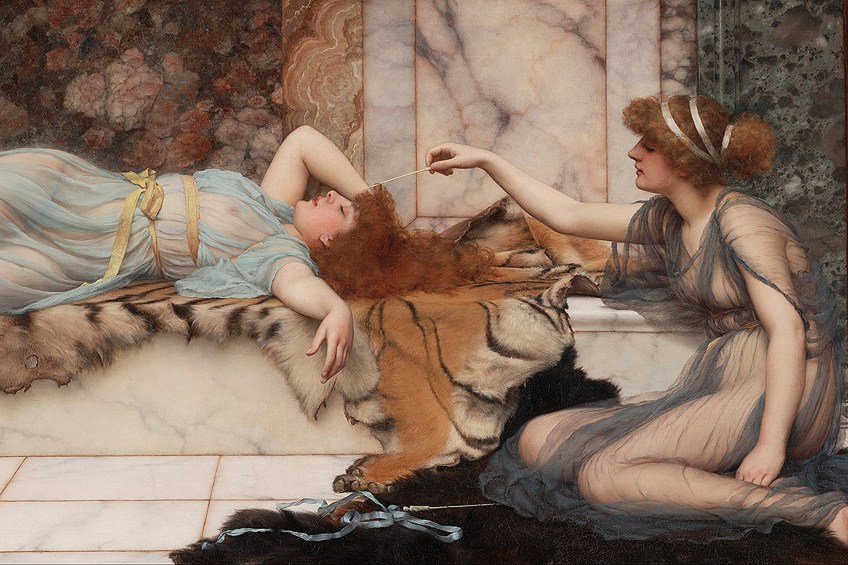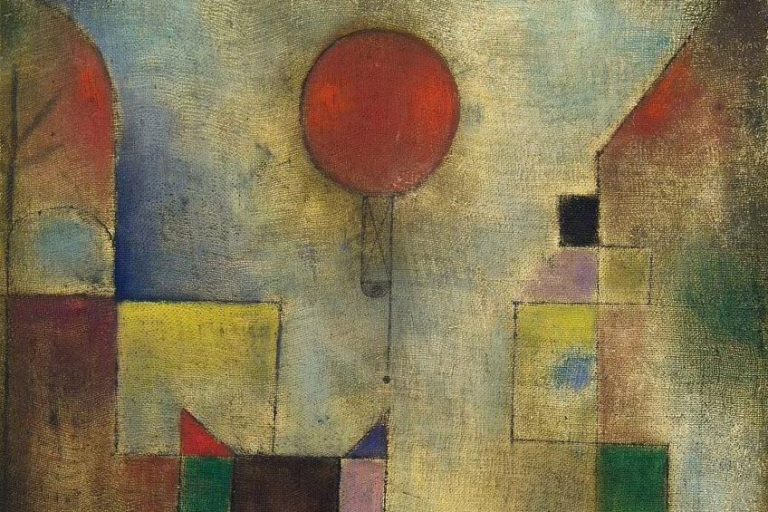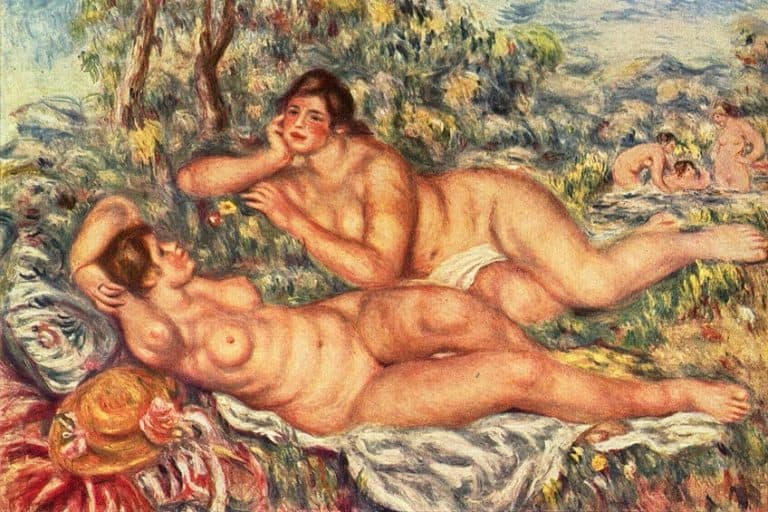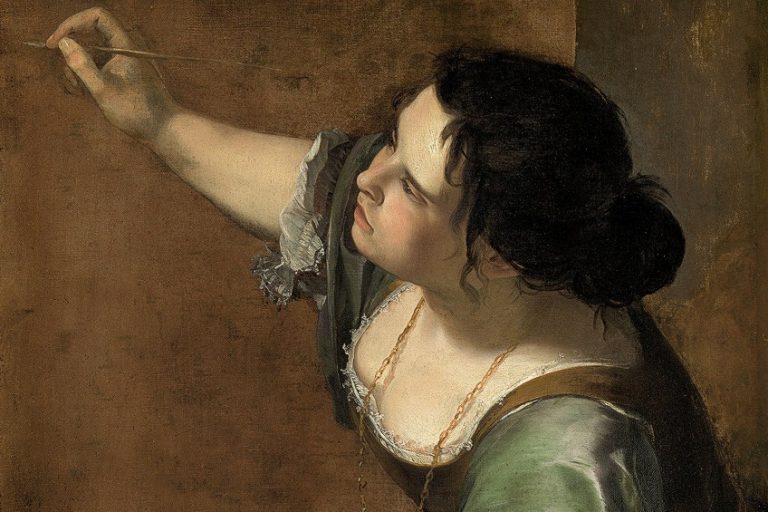Famous Neoclassical Paintings – 10 Must-Know Artworks
The Neoclassicism movement emerged in Rome and was largely influenced by Johann Joachim Winckelmann’s published works at the time of the excavations of the Ancient Roman cities of Herculaneum and Pompeii. The rediscovery of the Classical style prompted the revived interest in Greco-Roman ideals regarding art, culture, and antiquities. This fascination with antiquity became the basis of inspiration for many magnificent works of art. After our own investigation, we have made a selection of 10 of the most famous Neoclassical paintings, which we will explore in this article.
The 10 Most Famous Neoclassical Paintings
The Neoclassical period spanned from the mid-1700s and continued into the 1800s. It paved the way for many incredible pieces of art. The Neoclassical movement encompassed ideals and themes from the past. The paintings were heavily influenced by the art and culture of Ancient Rome and Greece, and we see this exemplified in the style and subject matter of the paintings. The overall focus of these paintings was balance, order, technical skill, and historical accuracy.
Here is our selection of the 10 most famous Neoclassical paintings.
Parnassus (1761) by Anton Raphael Mengs
| Artist | Anton Raphael Mengs |
| Date Painted | 1761 |
| Medium | Oil on panel |
| Dimensions | 55 cm x 101 cm |
| Where It Is Currently Housed | State Hermitage Museum, St Petersburg, Russia |
Anton Raphael Mengs’ painting Parnassus was created as a sketch of his masterful fresco in the Villa Albani in Rome. Mengs’ fresco contributed to establishing the ascendancy of Neoclassicism paintings. In his painting Parnassus, Mengs had broken away from the Baroque traditions and incorporated the Neoclassical style art conventions.
The painting’s composition was inspired by Raphael’s fresco version of the Parnassus, in the Vatican Palace’s Stanza della Segnatura in Rome.
The central figure in the painting is Apollo, the God of the sun according to Greek mythology, and he carries a lyre and laurel wreath which are the recognizable symbols traditionally associated with him. On either side of Apollo, he is surrounded by muses. On the right, Mengs depicted Calliope, Euterpe, Polyhymnia, Urania, and Melpomene. To Apollo’s left, you will find Clio, Erato, Thalia, and Terpsichore.
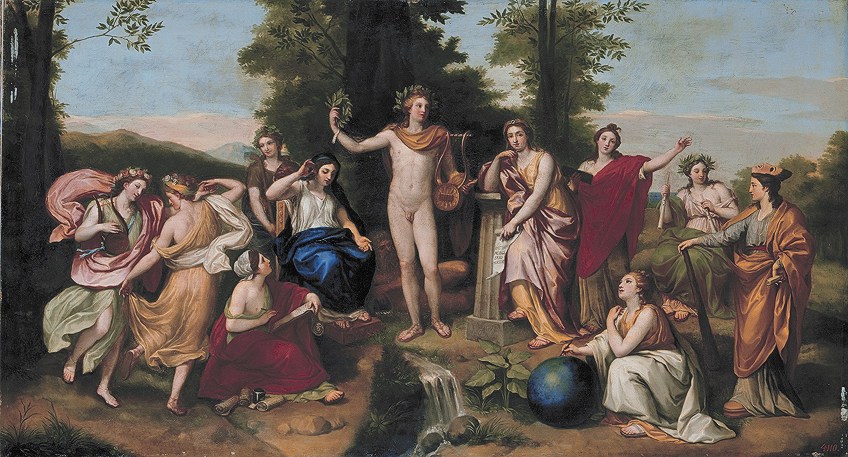
J.J. Winckelmann the art historian, who was a close friend to Mengs, advised him to keep the composition of Parnassus simple, uncrowded and shallow; with the figures depicted as statuesque in static poses. Although one can see the influence of Raphael in Mengs’ portrayal, the composition of Mengs’ painting is still sufficiently original.
Among Mengs’ other influences were the ancient frescoes he had witnessed at the excavation sites at Pompeii and Herculaneum.
Mengs’ contribution to art was widely revered as he was considered to be one of Europe’s greatest painters during his time. His depiction of Parnassus played a significant role in establishing the popularity of Neoclassicism paintings in Italy, which then spread to the rest of Europe.
The Death of General Wolfe (1770) by Benjamin West
| Artist | Benjamin West |
| Date Painted | 1770 |
| Medium | Oil on canvas |
| Dimensions | 151 cm x 213 cm |
| Where It Is Currently Housed | National Gallery of Canada |
Benjamin West was a British-American painter who became famous for his paintings of historical scenes. One of his most famous Neoclassical paintings was The Death of General Wolfe completed in 1770. The painting is a portrayal of the Battle of Quebec at the moment of General James Wolfe’s death. General Wolfe is the central figure on the battlefield, he is lying down and his propped-up body acts as the base of the pyramidal shape that is formed by his surrounding officers that peaks at the partially raised flag, displaying a triangular composition.
The painting serves as an example of Neoclassical style art, this is evident from the way the pale faces of the figures are illuminated in a Christ-like manner which makes them the emotional focus of the painting.
On the left side of the painting, the figures are in a stance that conveys their distress in a manner that is reminiscent of the portrayals of the mourning of Christ. West’s painting conveys a sense of drama on the battlefield with the heroic sacrifice signifying the end of the battle which promotes the suggestion of martyrdom.
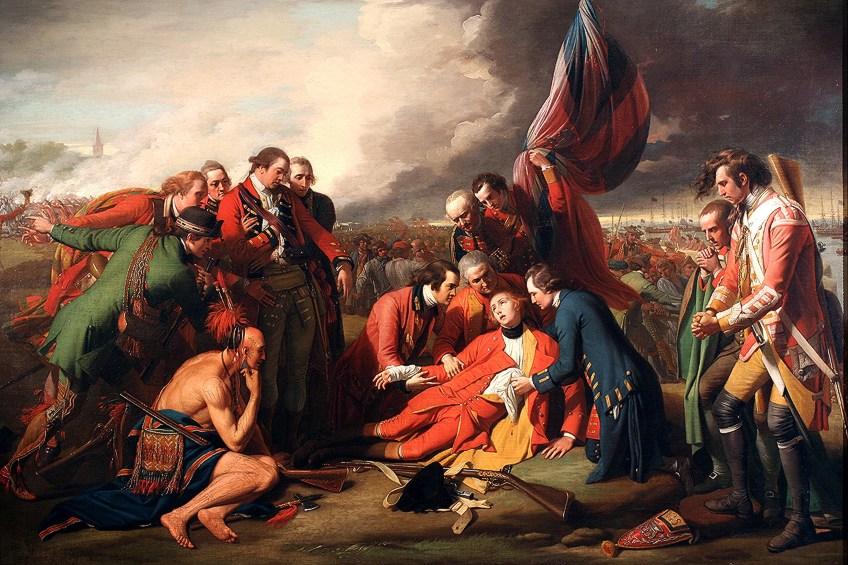
In this famous Neoclassical painting, West depicted a contemporary event and with it, he chose to dress his figures in modern uniforms rather than a more Classical-style costume. This was controversial at the time, but West’s innovative choice was made to promote historical accuracy. However, with the inclusion of certain identifiable figures, that were in fact absent at the battle, we come to understand West’s depiction of General Wolfe’s death as figurative rather than literal.
Although the inclusion of historical figures such as Captain Harvey Smythe, who is depicted holding Wolfe’s arm, give the painting a sense of historical importance; they, in turn, make West’s portrayal historically inaccurate.
In The Death of General Wolfe, we see West’s artistic interpretation of the historical event where the goal was to compose an iconic painting of the British hero General Wolfe. West’s choice to dress the figures in contemporary uniform went on to influence many artists towards painting contemporary historical scenes, which were otherwise painted in a Greek or Roman setting. Although a movement was already underway, West’s success with The Death of General Wolfe established the style of contemporary historical paintings.
Oath of the Horatii (1784) by Jacques-Louis David
| Artist | Jacques-Louis David |
| Date Painted | 1784 |
| Medium | Oil on canvas |
| Dimensions | 329.8 cm x 424.8 cm |
| Where It Is Currently Housed | Musée du Louvre, Paris, France |
The Neoclassical painter Jacques-Louis David has been considered the pioneer of Neoclassical painting. David’s Oath of the Horatii was immediately considered hugely successful by the public and critics and is considered as one of the most famous Neoclassical paintings from the movement. David’s painting depicted a Roman legend; a scene about two cities at war, Alba Longa and Rome. Each city chooses three of its men to send to fight, rather than entire armies being sent to war.
The victorious city would be determined by the victors in the fight.
The painting is a portrayal of the Roman Horatii family. The three sons stand in salute with their arms extended in allegiance towards their father who is holding their swords. Visually, the swords make up the central point of the image and the convergence of the figures’ hands balances the composition of the painting and further conveys the importance of solidarity, patriotic sacrifice, duty, and loyalty.

The Oath of Horatii shows the quintessential Neoclassical style art with components such as the heroic figures, the subdued colors, the strong lines, and the central perspective. David’s brushstrokes are not visible, especially in comparison to the previous movements such as the wispy brushstrokes apparent in the Rococo movement.
This technical choice is to highlight the significance of the story behind David’s artwork as opposed to focusing on the painting itself. There is no distraction from the subject matter.
The contrast of the dark background with the highlighted foreground creates a sense of somber resolve in the dramatic scene. The painting became a symbol for the French Revolution, where countrymen accepted and understood their responsibility and duty to their country. David’s Neoclassical period art depicted a story that was morally uplifting, it promoted the importance of civic duty and reflected the values associated with Neoclassical idealism and the Age of Enlightenment.
Cornelia, Mother of the Gracchi, Pointing to her Children as Her Treasures (c. 1785) by Angelica Kauffmann
| Artist | Angelica Kauffman |
| Date Painted | c. 1785 |
| Medium | Oil on canvas |
| Dimensions | 101.6 cm x 127 cm |
| Where It Is Currently Housed | Virginia Museum of Fine Arts, United States |
Angelica Kauffmann was a famous Swiss-born Neoclassical painter. In her Cornelia, Mother of the Gracchi, Pointing to her Children as Her Treasures painting, the Roman-style architecture frames the two women who are dressed in typical Ancient Roman clothing. The three children present in the painting are all clothed in togas, along with leather sandals. This famous painting exemplified a model of virtue.
With the revived interest in ancient art and culture, there was an increase in Neoclassicism paintings that portrayed stories of Classical antiquity.
The scene depicted in Kauffmann’s painting is about an ancient Roman woman, Cornelia, who mothered children that would become political leaders in the future. The painting illustrates an encounter between Cornelia, who is the central standing figure, and a Roman matron.
Cornelia’s visitor, who is the seated woman in red on the right side of the painting, has shown her exquisite gems and jewelry to Cornelia. When the visitor asks Cornelia to present her prized treasures in return, Cornelia humbly presents her children instead of showing her jewels and gems. Kauffmann skillfully depicted the visitor’s embarrassment and dismay with her furrowed eyebrow and slightly gaping mouth.

Angelica Kauffmann, Public domain, via Wikimedia Commons
Kauffmann’s historical paintings predominantly made female subjects from Classical mythology and history the focus. Kauffmann’s interpretation of Classical idealism and heroism ensured that women were included in the narrative and gave them a central role. She undermined the predominant conventions that made up the genre of historical painting and provided her audience with a new lens through which to experience history and its various representations.
The message behind the painting is clear: a woman’s most precious possessions are not material items, but her children who hold the future.
Neoclassical artwork was meant to improve the viewer by imparting a moral message, which was so aptly done in Kauffmann’s Neoclassicism paintings. Kauffmann had a crucial impact on the art scene in Britain. Kauffmann’s Cornelia, Mother of the Gracchi, Pointing to her Children as Her Treasures rightfully positioned her as a pivotal influence of Neoclassical-style art.
King Lear Weeping over the Dead Body of Cordelia (1786 – 1788) by James Barry
| Artist | James Barry |
| Date Painted | 1786 – 1788 |
| Medium | Oil on canvas |
| Dimensions | 269.2 cm x 367 cm |
| Where It Is Currently Housed | Tate, London, United Kingdom |
James Barry was an Irish Neoclassical painter. He is considered a pioneer in the context of Irish art. Barry’s Neoclassical artwork King Lear Weeping over the Dead Body of Cordelia is from a collection that was made for Alderman Boydell’s Shakespeare Gallery. In this piece, a devastated King Lear is depicted holding the body of his daughter Cordelia.
Barry’s portrayal of the tragic scene has been set in a heroic landscape where Stonehenge can be seen in the background.
Barry’s decision to portray this particular moment of the plot of King Lear had left critics transfixed. Barry’s painting was able to deliver the plot, not through narrative, but by using stylistic codes and composition. If you pay attention to King Lear, he does not stand in the center of the painting, but he stands on the right side of the painting. It is important to note King Lear’s figure in relation to the other elements in the painting.
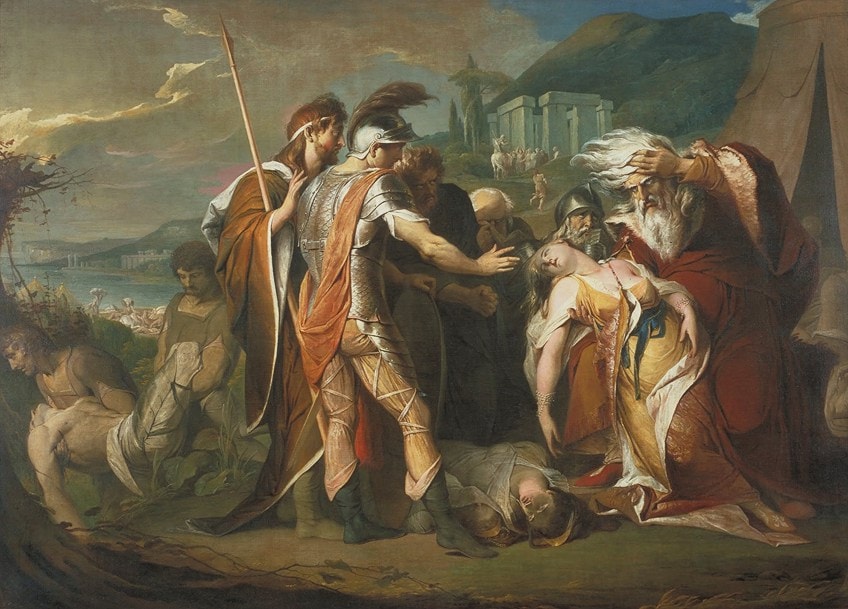
In the center of the painting Albany and Edgar, the virtuous men who are meant to inherit King Lear’s state, are portrayed in different stylistic modes. Edgar’s figure is heroically modeled after the Greek style, which fits with the overall style of the painting with its clear outlines, contours, and spatial organization apparent in Neoclassical period art. It is only King Lear’s figure that does not fit the scene, as if he is intruding on the Classical scene.
In effect, Barry’s Neoclassical artwork illustrates the two distinct styles from the 18th century that were associated with Raphael and Michelangelo. Barry favored Raphael’s elegance and discretion over Michelangelo’s grandeur.
Barry’s composition was strategic and demonstrated the importance of the antique while invalidating the nonantique, which he associated with the figure of King Lear.
Barry was a champion of Neoclassical period art and history painting. However, following his initial success as a Neoclassical painter, he was expelled from the Royal Academy of Arts in London. Barry died in poverty, but his work is widely recognized to this day, and he is still seen as the greatest 18th-century artist of Irish history painting.
Self-Portrait with Her Daughter (1789) by Elisabeth Louise Vigée Le Brun
| Artist | Elisabeth Louise Vigée Le Brun |
| Date Painted | 1789 |
| Medium | Oil on wood |
| Dimensions | 130 cm x 94 cm |
| Where It Is Currently Housed | Musée du Louvre, Paris, France |
Elisabeth Louise Vigée Le Brun was a notable French artist from the late 18th century known for her portraiture. Although Le Brun’s artistic style is largely considered to be in line with the Rococo style, her painting style adopted elements from Neoclassicism that made it consistent with the emergence of Neoclassical style art.
Le Brun’s modest portrait contrasted the abundant historical paintings and paintings of mythological subjects that populated the late 18th century and illustrated the intimacy between her and her daughter Julie.
The shadow cast on Julie’s right eye by Le Brun’s chin, as Julie is nestled against Le Brun’s neck, evokes a closeness and a sense of touch that can be felt by the viewer. Their arms are wrapped around each other, and their bodies together form a pyramid shape as if they are merged as one, with their faces expressing natural and genuine affection. The triangular composition of the figures is suggestive of Raphael’s Madonna and Child in his painting The Small Cowper Madonna. The reference to Raphael promotes a timeless quality.
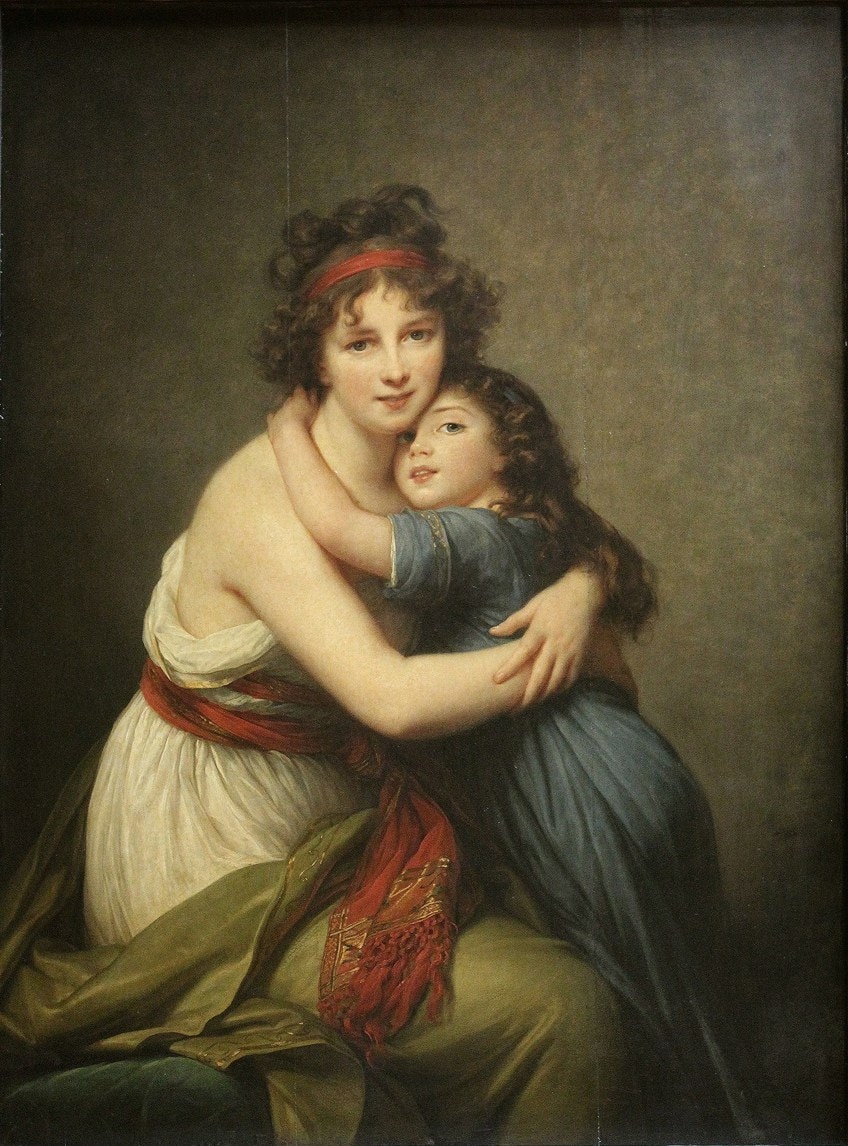
The bare background highlights their figures in a soft light. Le Brun has painted herself in a dress that is reminiscent of an Ancient Greek style. The portrayal of Ancient period clothing was influenced by Neoclassicism. You could interpret it as lending the importance of the Classical to the power of motherhood.
Le Brun adapts the typically stoic style of Neoclassicism paintings to one that depicts the intimacy between mother and daughter by painting their warm embrace.
Le Brun made quite the name for herself, in part because she served as Marie Antoinette’s portrait painter, which in itself illustrated her immense talents. It is important to remember that in the Royal Academy of Fine Arts in France only four positions were made available to artists who were women. Her ability to capture the universal affection between a mother and daughter and communicate their intimacy to the viewer demonstrates her brilliance as an artist and why she was one of the four women artists accepted into the Academy.
The Death of Marat (1793) by Jacques-Louis David
| Artist | Jacques-Louis David |
| Date Painted | 1793 |
| Medium | Oil on canvas |
| Dimensions | 162 cm x 128 cm |
| Where It Is Currently Housed | Royal Museums of Fine Arts of Belgium |
One of the most notable images of the French Revolution is Jacques-Louis David’s painting of the murdered Jean-Paul Marat, who was a French Revolutionary leader. Painted in 1793, the Neoclassical artwork depicts Marat’s dead body slumped over his bath covered in blood with his quill and a letter still in hand, after Charlotte Corday murdered him on the 13th of July 1793.
The original artwork sits in the Royal Museums of Fine Arts of Belgium, but a replica that was created by David’s studio is part of the Louvre exhibit in Paris.
Although Neoclassical period art was a revival of antiquity, it often featured contemporary subjects and scenes that were both important and relevant to the times. In The Death of Marat, Jacques-Louis David’s portrayal was a politically charged painting that depicted a crucial event in history. In keeping with the emphasis on historical accuracy and realism during the Neoclassicism movement, The Death of Marat depicts the political material without changing it.
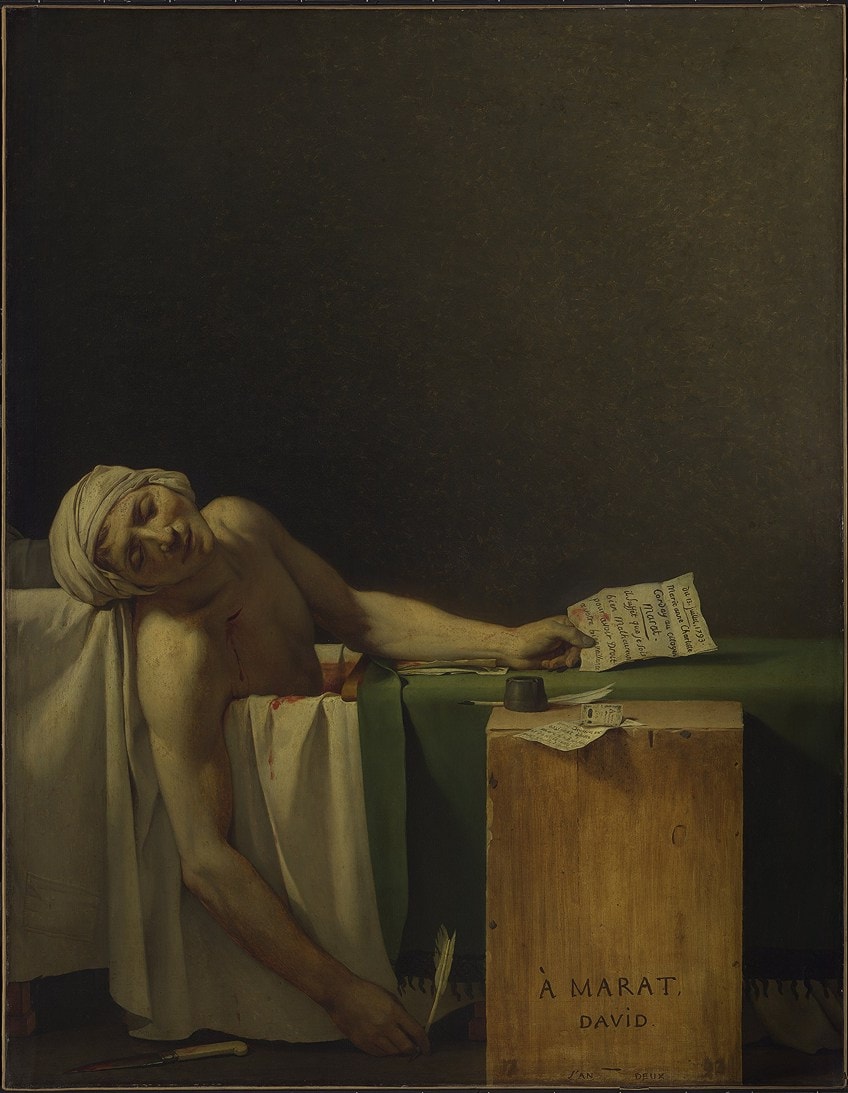
The painting shows off David’s signature style of Neoclassical painting. If you take a look at the composition, you will see that it is perfectly balanced; with Marat in the bathtub, a horizontal plane is formed in the foreground which counterbalances the painting’s minimalist background. The light dramatically illuminates Marat’s body along with the list in his hands, his quill, and the murder weapon that lies on the floor covered in blood.
If you pay particular attention to the portrayal of various details such as the setup of the bathtub, the green rug, and the pen and papers, you will notice that they are relatively true to life and realistic.
However, overall you will notice that style takes inspiration from Classical idealism. David’s depiction of Marat is idealized and portrays a flawless martyr rather than a realistic representation, such as painting Marat with unblemished skin rather than revealing his clearly evident dermatitis.
There is a similarity to Michelangelo’s Pietà, with both works depicting the hanging elongated arm; and Caravaggio’s Entombment of Christ, wherein both paintings emphasize the drama and light. Marat was depicted as the “martyr of the Revolution” where his body was highlighted in a glowing soft light, as done in Christian art.
David’s various references to Classical art cements its importance as a famous Neoclassical painting and contribution to the French Revolution.
The Turkish Bath (c. 1852 – 1862) Jean-Auguste-Dominique Ingres
| Artist | Jean-Auguste-Dominique Ingres |
| Date Painted | c. 1852 – 1862 |
| Medium | Oil on canvas |
| Dimensions | 108 cm x 110 cm |
| Where It Is Currently Housed | Musée du Louvre, Paris, France |
Jean-Auguste-Dominique Ingres was a notable French Neoclassical painter and one of his most famous Neoclassical paintings was The Turkish Bath. The painting was completed between 1852 and 1859, later modifications were made in 1862. Ingres depicted a group of women in the nude in various poses by a bath inside a harem. Ingres was able to evoke an earlier style that was more Western as well as the Ancient Near East through his painting to depict the mythological subject matter.
The Turkish Bath expanded on the various figures and motifs Ingres’ earlier paintings had explored. If you take a look at the central figure in the foreground whose back is turned while playing the mandolin, you will see that she is strikingly similar to the figure in The Valpinçon Bather from his 1808 painting. A great deal of inspiration was also taken from his Grande Odalisque painting from 1814. The figures in The Turkish Bath were not painted from live models, they were inspired by his previous paintings and drawings.
The painting is said to be largely based on an account by Lady Mary Montagu, whose passage described a Turkish harem, where she mentioned seeing two hundred women in various poses who were nonchalantly stretched out.

In Ingres’ depiction, he distorted and altered the anatomy of his nudes, in a manner he was known for, to produce figures that seemed almost boneless and sinuous. The figures are arranged in a manner that is harmonious and circular, with a curved positioning that intensifies the erotic nature of the painting.
Soft and cold light bathes the scene, where the women’s pale skin is counterbalanced by the subtle inclusion of exotic patterns, in the fabrics, jewels, and vases, which all contribute to the sense of exotic perfumes hanging in the air and the steamy warmth from the running water in the bathhouse.
Ingres incorporated Classical elements in his paintings which were typical of Neoclassical style art. Ingres made use of muted colors and emphasized linear design in his paintings, where his tight brushwork and technical skill created images that were more realistic. Ingres believed that it was actually line, rather than color, that conveyed emotion in his paintings.
Ingres’ work went on to influence Matisse and Picasso and can be viewed as a major precursor of the modern art movement.
The Birth of Venus (1879) by William-Adolphe Bouguereau
| Artist | William-Adolphe Bouguereau |
| Date Painted | 1879 |
| Medium | Oil on canvas |
| Dimensions | 300 cm x 218 cm |
| Where It Is Currently Housed | Musée d’Orsay, Paris, France |
The Birth of Venus is considered one of William-Adolphe Bouguereau’s most famous Neoclassical paintings. Bouguereau depicted the origin story of Venus from Roman Mythology. In Bouguereau’s Neoclassical style art, he depicted the transportation of Venus, as a fully matured nude woman, in a shell from the ocean to Paphos in Cyprus.
Venus, the Goddess of beauty and love, embodied the Classical Roman and Greek ideals of beauty and the female form.
The composition and subject matter are reminiscent of previous renditions of the painting from the Renaissance period, such as Raphael’s The Triumph of Galatea with its encircling cherubs and Sandro Botticelli’s The Birth of Venus. However, unlike Botticelli’s and Raphael’s portrayals, Bouguereau’s depiction of Venus mimicked the Neoclassicism paintings at the time with its Classical subject matter, and with a refined naturalism that incorporated the new artistic style at the time.
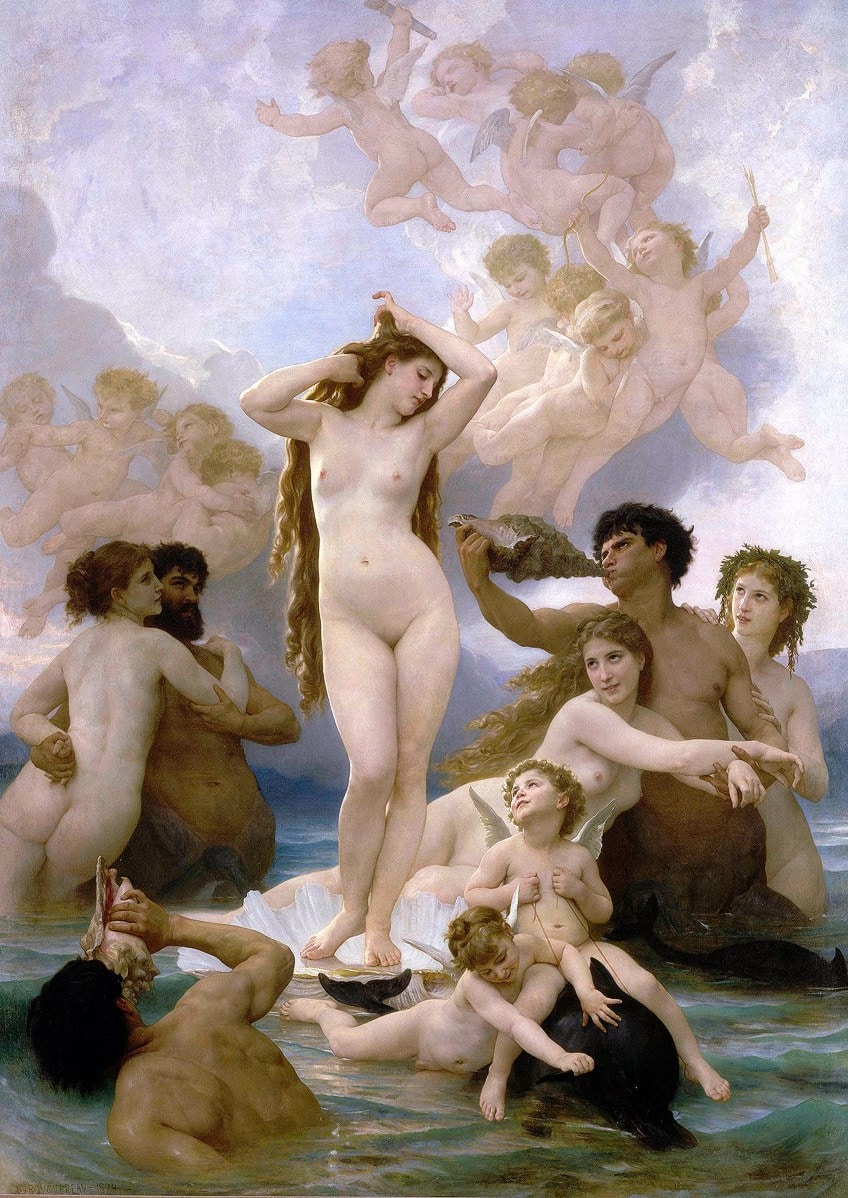
This painting was considered a masterpiece and illustrated Bouguereau’s technical skills, its sheer magnitude standing at three meters tall made Venus life-size. Although Bouguereau’s depiction of Venus appeared realistic, his portrayal still confined her to her role as an ideal. Bouguereau’s Venus is surrounded by admiring nymphs and cherubs, while elegantly standing in an “S” curved contrapposto pose that was Bouguereau’s interpretation of Venus Anadyomene, placing her into the Classical Roman and Greek tales of antiquity.
Bouguereau allows the viewer to inspect every aspect of Venus, unashamed of the sensuality and nakedness. Bouguereau’s painting in its technical perfection was deemed a great success, to which he received considerable acclaim.
Mischief and Repose (1895) by John William Godward
| Artist | John William Godward |
| Date Painted | 1895 |
| Medium | Oil on canvas |
| Dimensions | 60.6 cm x 133 cm |
| Where It Is Currently Housed | J. Paul Getty Museum, Los Angeles, United States |
John William Godward was a British painter who was one of the last Neoclassical painters from the movement. Godward’s Classical-inspired artworks, with their meticulous attentiveness to historical details and their sensual figures, reflected his sensitivity and complexity as an artist. His painting Mischief and Repose illustrates an interior scene from Ancient Rome or Greece, which followed the Neoclassical tradition.
The woman lying down on the left who is stretched out on top of a marble bench on a tiger skin is “Repose”, while the woman on the right who is seated on black animal skin is “Mischief”.
The women do not engage with the viewer and the cold, academic, Neoclassical style of the painting, along with Godward’s portrayal of their pale skin makes both of the figures appear as petrified statues, mimicking the rest of the marbled room.
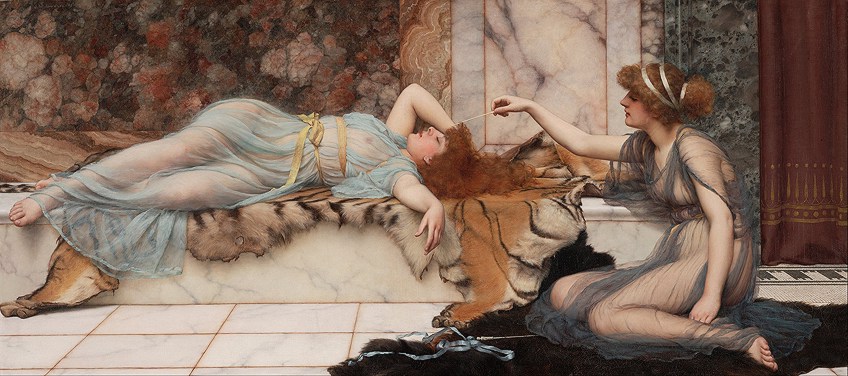
The two young women in Godward’s painting are dressed in flowing sheer robes that were modeled after ancient chiton. In order to achieve the sheer draping on his figures he first had to paint his models in the nude, then he would paint the draping on top of the models that he would then have to scrape off before that paint had completely dried so that he could create the sheer effect. His portrayals of marble in his paintings demonstrated the intense archaeological studying he did of the Classical period, he was widely regarded as the master of this craft.
Godward showcased his technical skills in his paintings. His attention to detail was impressive, as he would spend time researching the various elements that would be depicted in his artwork, including the architecture and the dress he would feature in his paintings. This was all in an attempt to make his depictions as realistic as possible. This dedication to his craft made Godward a master of Neoclassical period art which is why he was regarded as one of the most talented painters from the movement.
What Did the Neoclassical Period Stand For?
Neoclassicism is a term that represents the movements that took place in Western visual and decorative arts that were predominantly inspired by the art and culture from Ancient Greece and Rome. The concept strongly held by the Ancient Greeks, that beauty existed in the external and the form, is important to keep in mind when trying to understand Neoclassicism.
We come to see that Neoclassicism was a revival of this Classical style; where technical skill, balance, and exact form were favored over the artist’s individuality.
In order to get a real sense of the Neoclassicism art movement, it is important to situate this period in history. Neoclassicism developed during the mid-18th century in reaction and opposition to the excessive frivolous and opulent nature of the Baroque and Rococo movements that came before it. Neoclassicism exemplified the rational thinking of the Age of Enlightenment that took place in the 18th century. The Neoclassical movement lasted until the early 19th century, where it competed with the Romanticism movement.
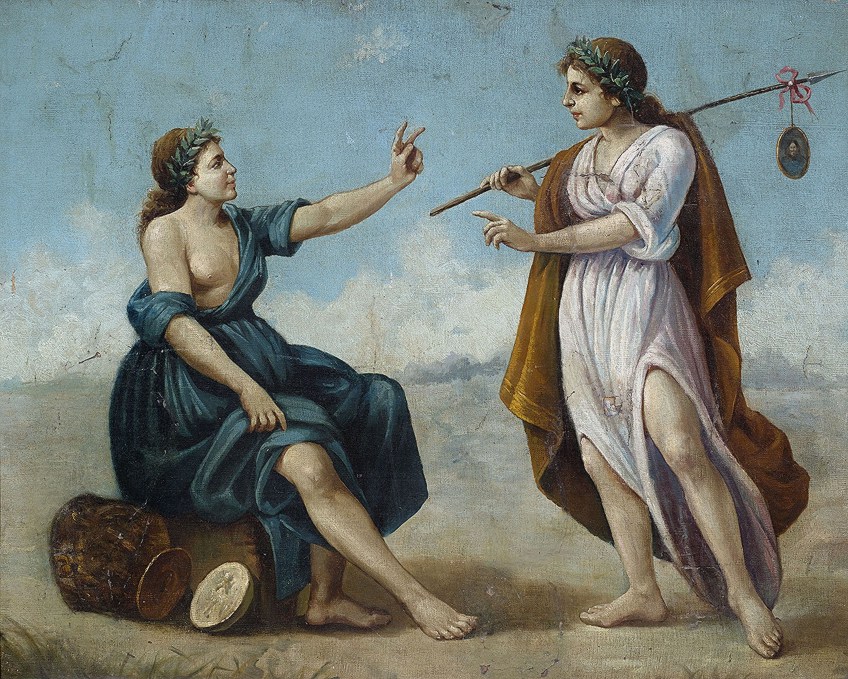
The archaeological findings from the excavations of the Ancient Roman cities of Herculaneum and Pompeii during the 18th century warranted a reintroduction of Classical art. Johann Joachim Winckelmann, a German art historian and archeologist, published works that followed these excavations which in turn revived the interest in classicism in the artwork.
This re-established interest soon spread throughout Europe along with the prominence of the Grand Tour.
Rome was at the forefront of Neoclassicism, but the movement soon expanded to the rest of Europe. When art students were returning from their Grand Tour trip to Italy, they brought with them innovative ideas prompted by the rediscovery of Greco-Roman ideals regarding art, culture, and antiquities. This became the basis of inspiration for many incredible famous Neoclassical paintings.

Neoclassical artwork was characterized by its use of shallow space, non-dynamic and strong lines, dark and subdued colors, without discernible brushstrokes, and clear forms to express moral portrayals of self-sacrifice and self-denial. Paintings from this movement were represented by well-composed, historically accurate settings and costumes.
Neoclassicists believed that art was meant to be of a serious nature. These paintings utilized restraint and calmness.
Neoclassical artwork focused on heroic depictions from Classical history and literature that were in line with the presumed ethical superiority of antiquity. Put simply, Neoclassicism was more than an art movement. In fact, French Neoclassicists were in support of the French Revolution and used their art to express their beliefs in support of the political upheaval.
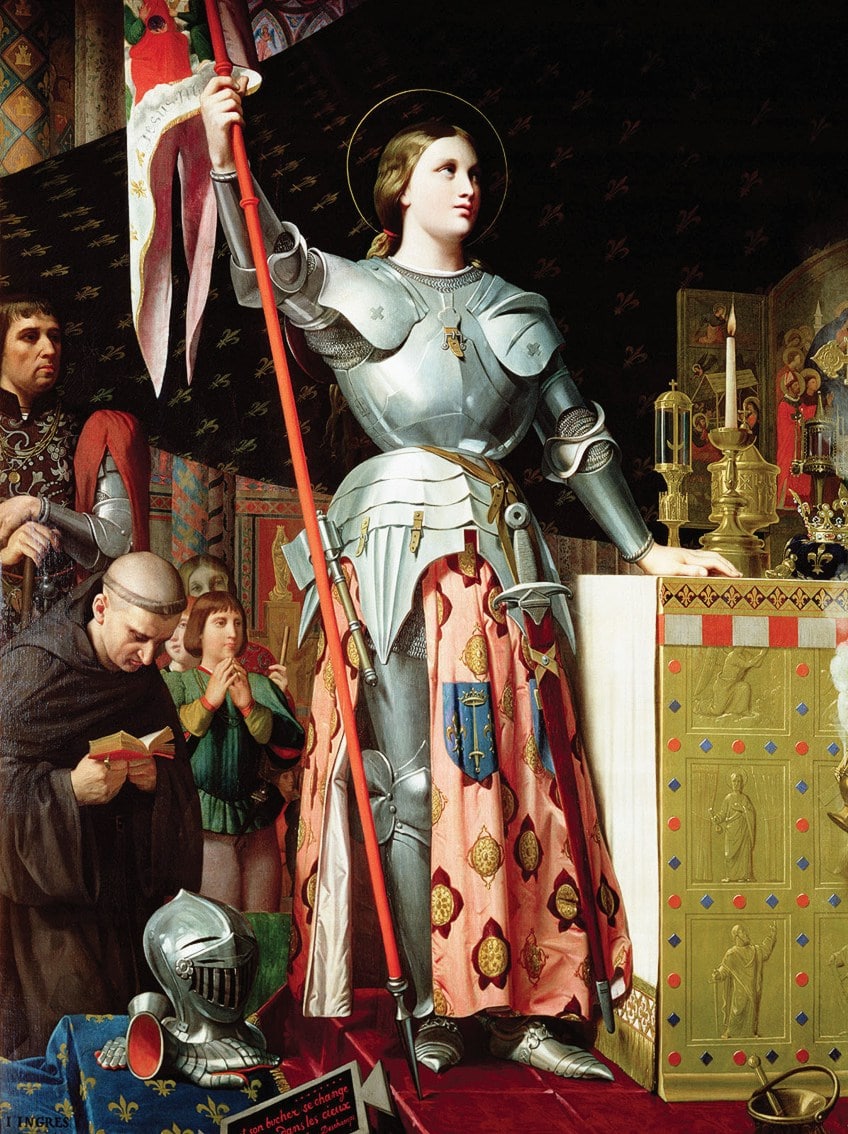
The famous Neoclassical paintings we discussed in this article remain influential works of art. The movement, which was a revival of the Classical style of Ancient Rome and Greece, produced a vast selection of inspired and truly magnificent paintings. While our list only contains our pick of the 10 most famous Neoclassical paintings, it is important to note that there are many magnificent Neoclassicism paintings outside of this list. If you enjoyed our article, we encourage you to continue exploring our website, where you will find many more art topics to discover.
Take a look at our Neoclassical paintings webstory here!
Frequently Asked Questions
What Did Neoclassical Art Focus On?
The Neoclassical movement focused on the preceding art styles of Ancient Rome and Greece. Neoclassicism was more focused on appreciating antiquity, rather than embracing it as a way of life, as the Neoclassical period often featured contemporary subjects and scenes. The primary belief from this era was that Neoclassical artwork should express ideal virtues and could therefore impart a moralizing sentiment to viewers.
What Are the Characteristics of Neoclassical Paintings?
Neoclassical artwork was characterized by its use of shallow space, non-dynamic and strong lines, dark and subdued colors, without discernible brushstrokes, and clear forms to express moral portrayals of self-sacrifice and self-denial. Paintings from this movement were represented by well-composed, historically accurate settings and costumes. These paintings utilized restraint and calmness.
Isabella studied at the University of Cape Town in South Africa and graduated with a Bachelor of Arts majoring in English Literature & Language and Psychology. Throughout her undergraduate years, she took Art History as an additional subject and absolutely loved it. Building on from her art history knowledge that began in high school, art has always been a particular area of fascination for her. From learning about artworks previously unknown to her, or sharpening her existing understanding of specific works, the ability to continue learning within this interesting sphere excites her greatly.
Her focal points of interest in art history encompass profiling specific artists and art movements, as it is these areas where she is able to really dig deep into the rich narrative of the art world. Additionally, she particularly enjoys exploring the different artistic styles of the 20th century, as well as the important impact that female artists have had on the development of art history.
Learn more about Isabella Meyer and the Art in Context Team.
Cite this Article
Isabella, Meyer, “Famous Neoclassical Paintings – 10 Must-Know Artworks.” Art in Context. October 30, 2021. URL: https://artincontext.org/famous-neoclassical-paintings/
Meyer, I. (2021, 30 October). Famous Neoclassical Paintings – 10 Must-Know Artworks. Art in Context. https://artincontext.org/famous-neoclassical-paintings/
Meyer, Isabella. “Famous Neoclassical Paintings – 10 Must-Know Artworks.” Art in Context, October 30, 2021. https://artincontext.org/famous-neoclassical-paintings/.


